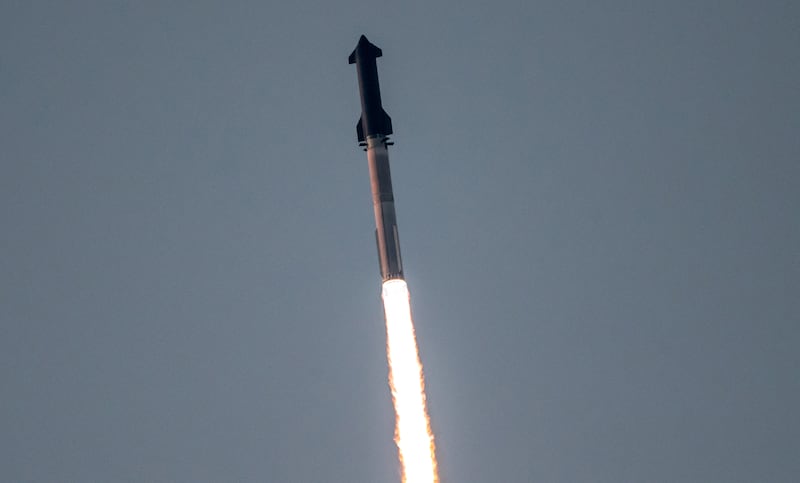SpaceX’s Starship rocket thundered off its Texas launch pad on Sunday in a fifth major test flight that included completing the first-ever “catch” of the vehicle’s booster after it returned from space.
The largest and most powerful rocket ever developed lifted off at 8:25am New York time. After propelling Starship to space, the Super Heavy booster returned to its launch site on Earth, where it slowed itself down as it came in for landing. Two arms protruding from Starship’s launch tower then “caught” the booster as it lowered itself down to the ground, as cheers and applause erupted at mission control.
“I am still in disbelief,” Jessie Anderson, a SpaceX engineer said during the live webcast. “I’m trying to catch my tears just like the chopsticks caught the booster.”
Recovering Starship’s booster after launch is a crucial milestone for SpaceX as it readies the rocket for commercial operations. The vehicle is the centrepiece of SpaceX chief executive officer Elon Musk’s ambitions of sending people to the moon and Mars. But it has a long road ahead before it launches crew and cargo.
READ MORE
Musk has long touted that the vehicle will be fully reusable. The company is known for recovering its workhorse Falcon 9 rockets after launch, but those spacecraft are only partly reusable, with a portion of the vehicles still being destroyed or left unused after the mission is over.
With Starship, SpaceX’s eventual aim is to fully recover the vehicle’s two main parts: the Starship spacecraft itself – which will carry satellites and eventually passengers – and the Super Heavy booster.

By recovering both of these pieces after flight, SpaceX hopes to rapidly reuse and relaunch the hardware following take-off, allowing for multiple flights of Starship in a single day. The company also expects full reusability to drastically lower the cost of launching Starship.
Like the Falcon 9, Starship’s Super Heavy booster came back to Earth using fins to help guide it through the atmosphere. It reignited its engines to help lower itself down to the ground slowly. But unlike the Falcon 9 – which lands on a hard surface with a set of landing legs – Super Heavy was caught just before it touched the ground.
Sunday’s flight was the first time that SpaceX attempted this feat with Super Heavy. On Starship’s fourth flight in June, the company attempted to “land” Super Heavy in the Gulf of Mexico, aiming for a pinpoint target in the ocean.
The mission unfolded against the backdrop of Musk openly criticising the speed at which the FAA approves commercial space launch licenses. SpaceX has been raising the concern in recent years as it tries to launch Starship more frequently. In September, the company said the FAA notified it that the license for this mission wouldn’t be granted until late November – a timeline that SpaceX said was slow and inefficient.
Apart from the booster catch, Starship’s flight looks fairly similar to its June flight. SpaceX launched the Starship and Super Heavy booster together. The flight is ongoing. Starship is meant to circle most of the globe before plunging through the atmosphere and splashing down in the Indian Ocean.
During the last flight, Starship survived much of the descent to Earth, but started to break apart during the fall and eventually burned up completely before it could hit the ocean. SpaceX said that it has completely reworked the heat shield on Starship for this flight to help it withstand the intense heating it experiences while falling through the atmosphere.
With each of these Starship test flights, SpaceX doesn’t necessarily deem the loss of its vehicles as failures. The goal for the company is to continue improving with each subsequent test flight. So far, the company has been able to achieve more goals with every new launch. – Bloomberg











